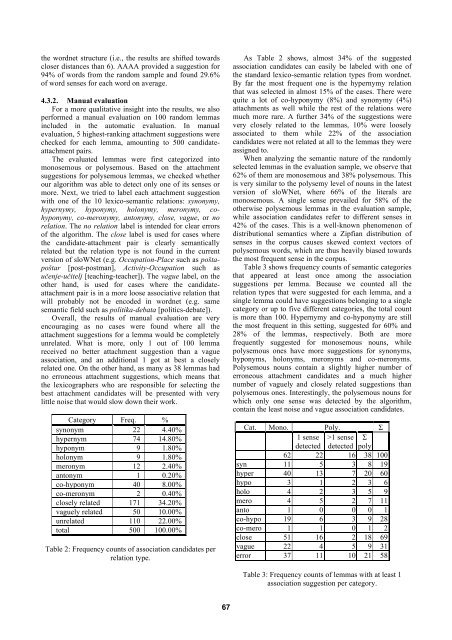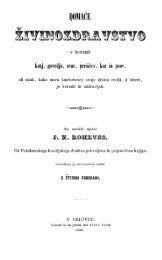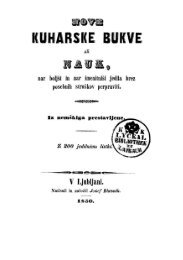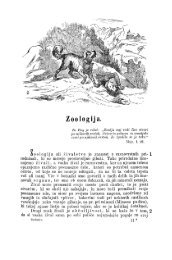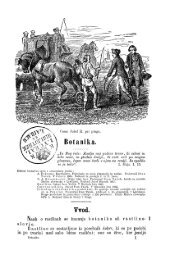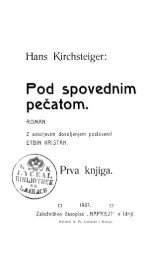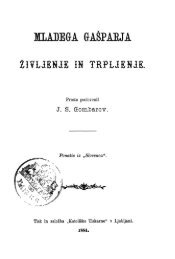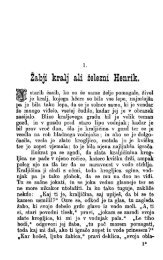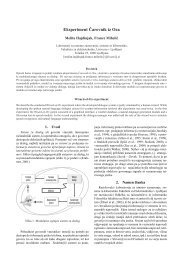Proceedings - Natural Language Server - IJS
Proceedings - Natural Language Server - IJS
Proceedings - Natural Language Server - IJS
You also want an ePaper? Increase the reach of your titles
YUMPU automatically turns print PDFs into web optimized ePapers that Google loves.
the wordnet structure (i.e., the results are shifted towards<br />
closer distances than 6). AAAA provided a suggestion for<br />
94% of words from the random sample and found 29.6%<br />
of word senses for each word on average.<br />
4.3.2. Manual evaluation<br />
For a more qualitative insight into the results, we also<br />
performed a manual evaluation on 100 random lemmas<br />
included in the automatic evaluation. In manual<br />
evaluation, 5 highest-ranking attachment suggestions were<br />
checked for each lemma, amounting to 500 candidateattachment<br />
pairs.<br />
The evaluated lemmas were first categorized into<br />
monosemous or polysemous. Based on the attachment<br />
suggestions for polysemous lemmas, we checked whether<br />
our algorithm was able to detect only one of its senses or<br />
more. Next, we tried to label each attachment suggestion<br />
with one of the 10 lexico-semantic relations: synonymy,<br />
hypernymy, hyponymy, holonymy, meronymy, co-<br />
hyponymy, co-meronymy, antonymy, close, vague, or no<br />
relation. The no relation label is intended for clear errors<br />
of the algorithm. The close label is used for cases where<br />
the candidate-attachment pair is clearly semantically<br />
related but the relation type is not found in the current<br />
version of sloWNet (e.g. Occupation-Place such as poštapoštar<br />
[post-postman], Activity-Occupation such as<br />
učenje-učitelj [teaching-teacher]). The vague label, on the<br />
other hand, is used for cases where the candidate-<br />
attachment pair is in a more loose associative relation that<br />
will probably not be encoded in wordnet (e.g. same<br />
semantic field such as politika-debata [politics-debate]).<br />
Overall, the results of manual evaluation are very<br />
encouraging as no cases were found where all the<br />
attachment suggestions for a lemma would be completely<br />
unrelated. What is more, only 1 out of 100 lemma<br />
received no better attachment suggestion than a vague<br />
association, and an additional 1 got at best a closely<br />
related one. On the other hand, as many as 38 lemmas had<br />
no erroneous attachment suggestions, which means that<br />
the lexicographers who are responsible for selecting the<br />
best attachment candidates will be presented with very<br />
little noise that would slow down their work.<br />
Category Freq. %<br />
synonym 22 4.40%<br />
hypernym 74 14.80%<br />
hyponym 9 1.80%<br />
holonym 9 1.80%<br />
meronym 12 2.40%<br />
antonym 1 0.20%<br />
co-hyponym 40 8.00%<br />
co-meronym 2 0.40%<br />
closely related 171 34.20%<br />
vaguely related 50 10.00%<br />
unrelated 110 22.00%<br />
total 500 100.00%<br />
Table 2: Frequency counts of association candidates per<br />
relation type.<br />
67<br />
As Table 2 shows, almost 34% of the suggested<br />
association candidates can easily be labeled with one of<br />
the standard lexico-semantic relation types from wordnet.<br />
By far the most frequent one is the hypernymy relation<br />
that was selected in almost 15% of the cases. There were<br />
quite a lot of co-hyponymy (8%) and synonymy (4%)<br />
attachments as well while the rest of the relations were<br />
much more rare. A further 34% of the suggestions were<br />
very closely related to the lemmas, 10% were loosely<br />
associated to them while 22% of the association<br />
candidates were not related at all to the lemmas they were<br />
assigned to.<br />
When analyzing the semantic nature of the randomly<br />
selected lemmas in the evaluation sample, we observe that<br />
62% of them are monosemous and 38% polysemous. This<br />
is very similar to the polysemy level of nouns in the latest<br />
version of sloWNet, where 66% of the literals are<br />
monosemous. A single sense prevailed for 58% of the<br />
otherwise polysemous lemmas in the evaluation sample,<br />
while association candidates refer to different senses in<br />
42% of the cases. This is a well-known phenomenon of<br />
distributional semantics where a Zipfian distribution of<br />
senses in the corpus causes skewed context vectors of<br />
polysemous words, which are thus heavily biased towards<br />
the most frequent sense in the corpus.<br />
Table 3 shows frequency counts of semantic categories<br />
that appeared at least once among the association<br />
suggestions per lemma. Because we counted all the<br />
relation types that were suggested for each lemma, and a<br />
single lemma could have suggestions belonging to a single<br />
category or up to five different categories, the total count<br />
is more than 100. Hypernymy and co-hyponymy are still<br />
the most frequent in this setting, suggested for 60% and<br />
28% of the lemmas, respectively. Both are more<br />
frequently suggested for monosemous nouns, while<br />
polysemous ones have more suggestions for synonyms,<br />
hyponyms, holonyms, meronyms and co-meronyms.<br />
Polysemous nouns contain a slightly higher number of<br />
erroneous attachment candidates and a much higher<br />
number of vaguely and closely related suggestions than<br />
polysemous ones. Interestingly, the polysemous nouns for<br />
which only one sense was detected by the algorithm,<br />
contain the least noise and vague association candidates.<br />
Cat. Mono. Poly. Σ<br />
1 sense >1 sense Σ<br />
detected detected poly<br />
62 22 16 38 100<br />
syn 11 5 3 8 19<br />
hyper 40 13 7 20 60<br />
hypo 3 1 2 3 6<br />
holo 4 2 3 5 9<br />
mero 4 5 2 7 11<br />
anto 1 0 0 0 1<br />
co-hypo 19 6 3 9 28<br />
co-mero 1 1 0 1 2<br />
close 51 16 2 18 69<br />
vague 22 4 5 9 31<br />
error 37 11 10 21 58<br />
Table 3: Frequency counts of lemmas with at least 1<br />
association suggestion per category.


